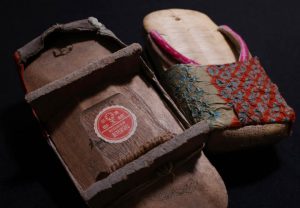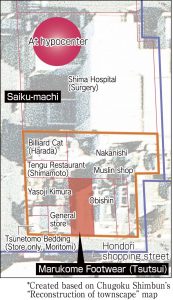Striving to fill voids in Hiroshima—Recreating cityscapes: Geta purchased in former Saiku-machi area, kept by Ms. Matsumoto, tell of life near hypocenter before A-bombing
Aug. 3, 2022
Geta with sticker from store makes for important historical material
by Rina Yuasa, Staff Writer
A pair of geta wooden footwear has been kept over the years by Sachiko Matsumoto (née Kiyoyoshi), a resident of Hiroshima’s Minami Ward, 97. Ms. Matsumoto bought the pair of geta at a footwear shop in the area formerly called Saiku-machi, located to the south of Shima Hospital (now Shima Internal Medicine Hospital, in Hiroshima’s Naka Ward), which is known for marking the location of the A-bombing hypocenter (the spot on the ground directly below the A-bomb’s detonation). A sticker retaining its original vivid red color on the bottom of the geta reads “Marukome, Saiku-machi, Hiroshima, Specially made by Matsuzakaya, Kakigara-cho, Tokyo.” The geta give a sense of the flourishing part of Hiroshima before the atomic bomb was dropped by the U.S. military.
The Marukome Footwear shop was located on the Hondori shopping street and can be found on the “Reconstruction of townscape” map, created by the Chugoku Shimbun in 2000 in an effort to “recreate” the area at and around the hypocenter. Her mother bought her the geta after she graduated from a girls’ high school around the age of 18. “The shelves of the cozy little store were lined with lots of footwear. I tried on a few pairs,” Ms. Matsumoto said. She considered especially charming the pink geta straps and geta covers made of dapple-dyed cloth to protect against rain.
Ms. Matsumoto was born and raised in the former area of Sarugaku-cho, located about 200 meters to the northeast of the footwear shop. Even after people’s lives became harder during the war, she wore the geta when walking around the Hondori shopping street.
The entire area was destroyed in the atomic bombing. In the series of articles titled Record of Hiroshima: Photographs of the Dead Speak, published between 1998 and 2000, the Chugoku Shimbun investigated the circumstances of each victim who was at the hypocenter area. According to that information, four members of the Tsutsui family, which ran the Marukome Footwear shop, were killed in the bombing, but their remains were never recovered. Ms. Matsumoto had moved to the Futabanosato area (now part of Hiroshima’s Higashi Ward) about one year before the end of the war. Her daughter, Etsuko Oka, 73, who now lives in the city’s Naka Ward, found the geta while she was tidying up a closet at home earlier this year, in July.
The Hiroshima Peace Memorial Museum plans to hold before the end of this year a special exhibit based on the theme of the Saiku-machi and Sarugaku-cho areas of Hiroshima. Hironobu Ochiba, chief curator at the museum, said, “The owner of the geta has a clear memory, and with that, the footwear becomes important material that provides a glimpse of people’s lives at the hypocenter before the atomic bombing. I’m amazed by the vivid colors and high-quality preservation.”
(Originally published on August 3, 2022)









